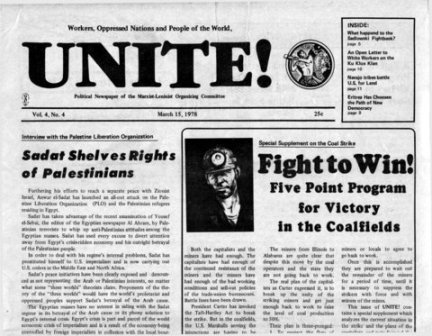
First Published: Unite!, Vol. 4, No. 4, March 15, 1978.
Transcription, Editing and Markup: Paul Saba
Copyright: This work is in the Public Domain under the Creative Commons Common Deed. You can freely copy, distribute and display this work; as well as make derivative and commercial works. Please credit the Encyclopedia of Anti-Revisionism On-Line as your source, include the url to this work, and note any of the transcribers, editors & proofreaders above.
Washington, D.C. – The Communist Party (Marxist-Leninist) – through its National Fightback Organization – organized a “March for Jobs” in Washington D.C. on February 18. Much of the march was militant and enthusiastic, a clear sign that the working class and oppressed masses are searching for a way to focus their anger. Yet those who came looking for class conscious leadership – for an understanding of the source of unemployment under capitalism and a strategy for fighting it – instead found an empty pep rally.
First announced last fall, the march and rally became a major campaign for the CP(ML). Over 2,000 people participated in some part of the demonstration.
The “March for Jobs” began at the White House. From there it went over two miles past the Capitol to the D.C. Coliseum, a large hall rented for the rally. The route of the march passed through northeast D.C, which is primarily Black.
While D.C. unemployment is not exactly comparable to cities like Detroit or Chicago – chiefly because most jobs in D.C. are tied to federal government rather than in large-scale industry – it is still enormous. In the course of the march, many onlookers showed great enthusiasm for the idea of united struggle against the system which produces unemployment, joining in the chants and shouting encouragement. Some joined the demonstration.
For those who came to the coliseum, the chief lesson of the rally was that the CP(ML) cannot provide leadership. Many of those who had joined the march left the coliseum in disgust. As marchers settled in the hall, they were met with empty “boogie” music.
No scientific understanding of the source and role of unemployment under capitalism was provided at the “March for Jobs”. The slogan of “class against class” was replaced by share-the-wealth and “poor against rich”. The nature of the state was hardly mentioned, much less explained.
CP(ML)’s main speaker at the rally, Central Committee member Odis Hyde, flung charges at the Rockefellers and the CIA, as if some conspiracy, rather than the capitalist system itself, were the source of unemployment. Instead of addressing the role of the union bureaucrats, he spoke only of George Meany, and then only to call him a CIA agent. This glosses over the main role of the union bureaucrats as agents of the bourgeoisie within the trade union movement.
Most flagrantly, Hyde and the whole CP(ML) campaign did not show the way to link up the struggle of the unemployed to the struggles of the employed working class. From start to finish, the CP(ML) in their shop work across the country promoted the idea that the problems of workers at U.S. Steel Gary or in GM Fremont could be solved by marching to Washington. The Jobs or Income Now campaign actively tried to pull workers out of the struggle on the shop floor and in the trade union to send them on a jaunt to D.C.
In its sum up editorial, in “The Call”, “On To Greater Victories in Jobs Fight” (March 6, 1978), the CP(ML) says the movement for jobs or income “can win jobs or other concessions from the ruling class”. But they overlook the fact that unemployment is an essential part of capitalism. The capitalist class can provide neither jobs nor income to the entire working class. Capitalism spontaneously creates a reserve army of unemployed both as a weapon of class struggle against the proletariat and as a labor pool which cushions the fits and starts of unplanned production.
The struggle against unemployment is part of the struggle of the working class as a whole. This struggle is against the entire capitalist class, its state, and its class collaborators.
Increasingly attempting to forge an alliance with the U.S. bourgeoisie against the U.S.S.R., the CP(ML) is inevitably thrown into the position of limiting its demands to illusionary concessions. It has moved solidly into reformism, with only a minimal cover of communism.